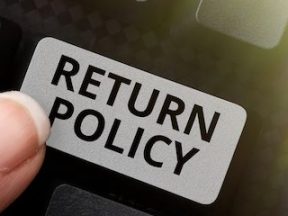Ecommerce returns are the invisible thorn for merchants, sapping profits through hidden shipping, restocking, and liquidation costs.
In response, many online retailers have changed lenient return policies, indicating the cost outweighs the sales benefit.

Some surveys show returns have been on the rise in recent years.
Cost of Returns
One way to think about the cost of ecommerce returns is with a minimal model that ignores the impact of lenient policies on overall sales and focuses instead on the cost and foregone revenue of the returned items.
For this model, let’s define seven variables.
Total unit sales (sold items) represents the complete count of units sold within a time frame. It serves as a starting point for the model, as any returns will be a subset of this total.
Average selling price describes the average price of sold items.
Average cost of goods is the cost incurred by the retailer to purchase or produce the items sold.
Average return rate is a crucial variable indicating the percentage of sold items that are eventually returned. The return rate can vary based on product, season, customer segment, and other factors.
Average shipping costs for returns encompass the expense to the customer for returning an item and the cost to the business for sending replacements. It can vary widely depending on the shipping method, geography, weight, and dimensions. Any miscalculation here can alter the apparent cost of returns.
Average restocking costs are associated with inspecting returned items, repackaging them, and restoring them to inventory. Restocking costs include labor, packaging materials, quality control, and refurbishments.
Average discounting and liquidation costs are the potential financial loss incurred by selling returned items at a lower price through discounts, liquidation, or disposal.
Note for my calculation of lost revenue, I’ll use both the average costs for restocking and for discounting and liquidation because an item could be restocked and eventually discounted or liquidated.
Calculations
Armed with those variables, we can make five key calculations.
Sales Revenue. Total sales before returns.
Sales Revenue = Total Units Sales (Sold Items) x Average Selling Price
Lost Revenue. Revenue lost due to returned items.
Lost Revenue = Total Units Sales (Sold Items) x Return Rate × Average Selling Price
Net Revenue. Sales Revenue minus the Lost Revenue.
Net Revenue = Sales Revenue - Lost Revenue
Gross Margin. Difference between the selling price and the cost of goods sold.
Gross Margin = Average Selling Price - Average Cost of Goods
Cost of Returns. Includes shipping costs, restocking fees, handling fees, and potential discounting or liquidation.
Cost of Returns = (Total Units Sales x Return Rate) x (Avg. Shipping Costs for Returns + Avg. Restocking Costs + Avg. Discounting and Liquidation Costs)
Example Using the Model
Next, I’ll create an example, using hypothetical figures to show how ecommerce returns impact an imagined online shop.
| Total Unit Sales (Sold Items) | 10,000 |
| Average Selling Price | $100 |
| Average Cost of Goods | $60 |
| Average Return Rate | 10% (0.10) |
| Average Shipping Costs for Returns | $5 |
| Average Restocking Costs | $2 |
| Average Discounting and Liquidation Costs | $10 |
Given these variables, we could make the calculations in the table below.
| Sales Revenue | $1,000,000 (Total sales before returns) |
| Lost Revenue | $100,000 (The revenue lost due to returned items) |
| Net Revenue | $900,000 (Sales Revenue minus Lost Revenue) |
| Gross Margin | $40 (Difference per item between selling price and cost) |
| Cost of Returns | $17,000 |
The owner of this hypothetical business would conclude that returns cost $17,000 in direct expenses and about $100,000 in lost revenue.
Putting a Model in Use
This simple model may not apply to your online store, but it could help measure the impact of ecommerce returns to make relatively better choices about a strategy.
In the model, a retailer would lose more if it shortened the return window from 30 days to 14 days, lowering the return rate by 1% but losing 1.5% of total sales. Hence changing the policy to boost profits would have backfired.
Here is the point. Ecommerce returns, though seemingly a minor part of retail, are material to a business’s profits.
The hidden costs of shipping, restocking, and liquidation — coupled with the intricacies of balancing customer satisfaction against bottom-line interests — reveal a complex returns ecosystem that demands close attention.
The model described here, while rudimentary, provides a framework.




